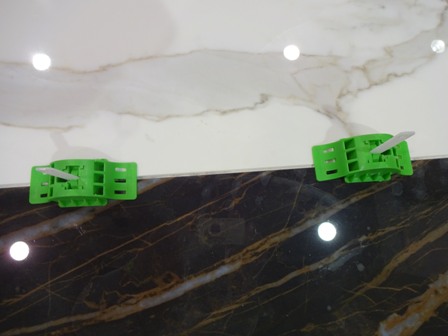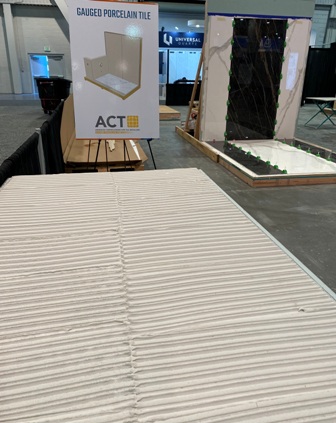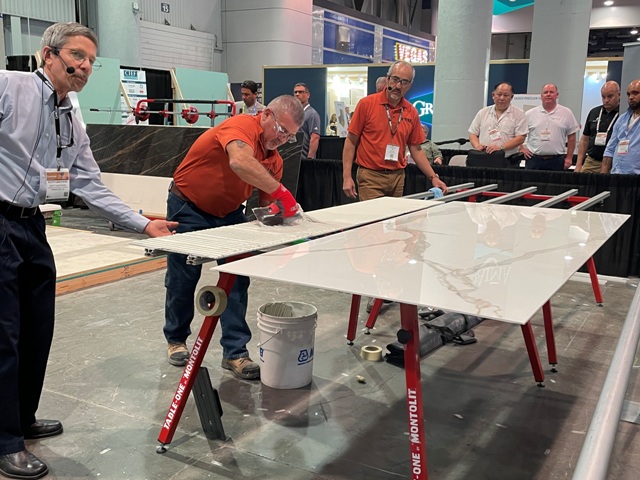We are finally beginning to see some normalcy return to our lives as the pandemic infection numbers are going down and hopefully, they will continue to do so. Coverings 2022 in Las Vegas was all about getting back to normal, with opportunities to actually interact in person with friends, colleagues, and new acquaintances.
Coverings 2022 also provided an opportunity for two tile industry non-profit organizations to demonstrate the safety requirements and proper installation techniques for one of the tile industry’s’ hottest new products – Gauged Porcelain Tile Panels (GPTP). The ongoing collaboration between the Ceramic Tile Education Foundation (CTEF) and the International Masonry Training and Education Foundation (IMTEF) — two of the six organizations responsible for the formation of the Advanced Certifications for Tile Installers (ACT) testing program — provided Coverings attendees with a firsthand look at the intricacies and techniques used in securing, handling, cutting, smoothing, fitting, spreading, and installing the one meter (39-3/8”) by three meters (118-1/8”) and larger panels by using the American National Standards Institute (ANSI) A108.19 & .20 installation standards.


Some folks have mistakenly said that GPTP is just like large-format tile (a tile 15” or longer on any one side), only bigger. This statement is not accurate and shows a complete misunderstanding of the GPTP product and the requirements needed to get it installed correctly. Realize that these panels range in size from 32.3 sq. ft., to just over 55 sq. ft. in one piece! That is comparable to just over two boxes to three and two-third boxes, respectively, of 12” x 12” tile.
There were several tools used in this demonstration to properly and safely handle the panels as listed here:


The culmination of the GPTP demonstration on the right, shows the completed contrasting panels on the floor and the wall. The ACT GPTP rendering shows the final result of a successfully-completed hands-on test. The left foreground shows the proper mortar troweling technique used to obtain the required mortar coverage.
- A sturdy work table adequately sized to handle the panel while also allowing the adjustability needed to obtain a perfectly flat working surface.
- Gloves – Nitrile to protect the skin from the high-alkalinity, cement-based mortars and vinyl-coated or ANSI-rated cut-resistant gloves to protect the skin from sharp tile edges.
- A rack system which includes up to eight specialized suction cups ineeded to lift, transport, and install the panel while maintaining it in a rigid and flat plane.
- A straight-line scoring system to cut the panel to the appropriate size and shape along with a good quality diamond pad to remove any sharp edges prior to handling and installing.
- Trowels which are recommended in the A108.19/20 installation standard, which calls for the mortar to be keyed into both the substrate and the panel with the flat side of the trowel. The notched side of the trowel is used to meter the required amount of mortar on both the substrate and the panel parallel to the short side of the panel.
- A beating panel and vibrating sander. The ANSI standard procedures call for the use of a beating paddle and vibrating sander to expel the air under the panel on vertical substrates and utilizing the GPTP “shuffle” of walking the panel in using a very specific foot movement.
- A lippage control system to keep the panel edges flat (in plane) to one another until the mortar has set up.
These panels appear to be the wave of the future for those who obtain the proper tools and training necessary to install them correctly the first time. All of these materials and methods were used at Coverings 2022 by CTEF and IMTEF experts to demonstrate the ANSI Standards for the panel, its installation, and most importantly, handling and installing it safely.
Images courtesy of CTEF and IMTEF.


Scott Carothers
Scott Carothers is the Acdemic Director for the Ceramic Tile Education Foundation (CTEF) and is responsible for the creation of the Certified Tile Installer (CTI) program, and is involved in the creation of the Advanced Certifications for Tile Installers (ACT) program as well as providing training to others in the tile industry.
Carothers has been involved in the ceramic tile industry for nearly 40 years and was the owner of a successful retail and installation firm prior to CTEF. He has served as President and Chairman of the Board of the National Tile Contractors Association (NTCA), Chairman of the NTCA Technical Committee, was named the NTCA Tile Person of the Year in 2005, and the NTCA Ring of Honor recipient in 2013. He is a voting member of the ANSI and the TCNA Handbook committees.







